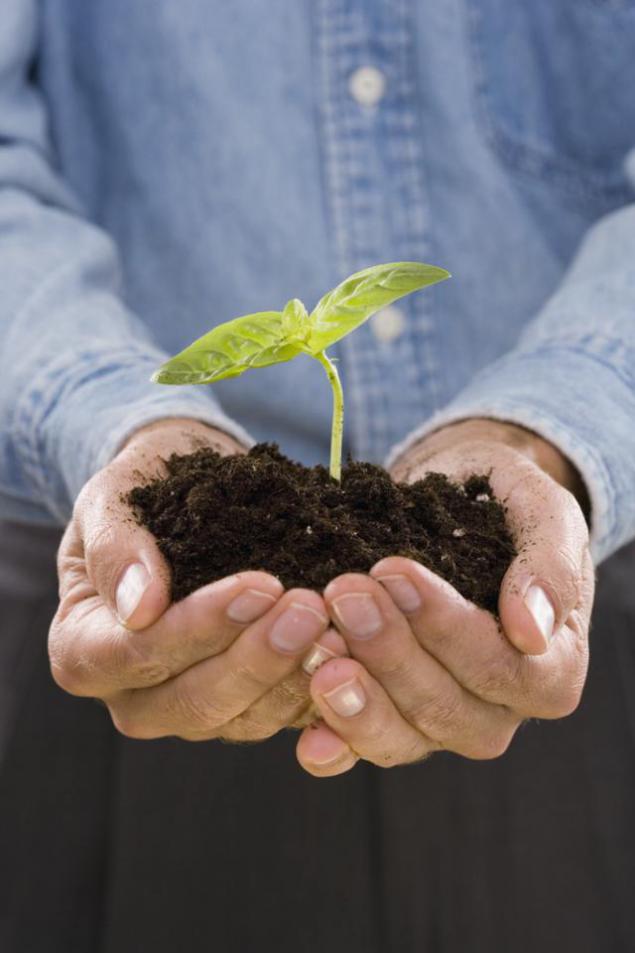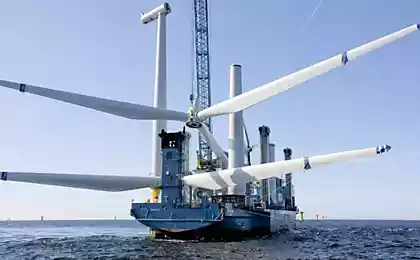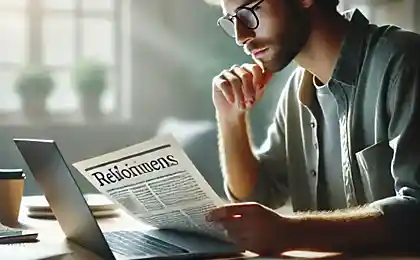737
Selection of environmental facts
Selection of environmental facts:

- How many people born in the history of mankind on the planet? According to rough calculations by the year 2002 on Earth was born from a total of 106 to 140 billion Homo sapiens.
- By 2025, more than 2, 8 billion people in 48 countries will experience water shortages. By 2050, the number of people who are constantly experiencing water shortages will reach 7 billion.
- 70% of all fresh water withdrawn from the environment a person goes to irrigate farmland.
- To produce 1 kg of chocolate you need 24,000 liters of water, 1 kg of meat - 15 500 liters, 1 kg of olives - 4400 liters, 1 kg of sugar - 1500 liters, 1 cup of coffee - 140l.
- 38% of the Earth's surface is threatened by desertification.
- According to the most conservative estimates for the last 200 years manmade in the atmosphere were about 2, 1 billion tons of CO2, with the acidity of the waters of the oceans has increased by 30% (pH decreased to 0, 1).
- Over the past 50 years, Canada's permafrost retreated to the north for 130 km.
- Since 1980, global energy consumption has increased from 7300 to 17.4 trillion kWh /
- After 10 years the volume of toxic electronic waste in the world will increase by 500 times
- 71 species of birds disappeared in Hawaii since man first landed on the shores of these islands.
- Currently in the world there are 17 species of penguins, of which 12 species population steadily declining
- Annual revenue from the industrial catch of bluefin tuna is 7, 2 billion dollars. Currently, the number of bluefin tuna declined by 70% since 1980.
- According to the calculations of researchers at the Carnegie Institution for every American accounts for 2, 5 tons of CO2, emitted into the atmosphere by industry in developing countries. For the average European citizen, this value is about 4 tonnes of CO2.
- In 2004, the rate of extinction of living organisms increased 100-1000 times compared to prehistoric times when man was not the master of the fate of all life on Earth. According to preliminary estimates for the next 20 years, the rate of species extinction may increase 10,000 fold compared to background (prehistoric) level.
- 75% of the Earth's surface is covered by water. 97, 5% of the planet's water is concentrated in the oceans, and only 2, 5% is fresh water. 70% of all fresh water is concentrated in the ice. Of the remaining 30% most of the fresh water is polluted, and only 1% of water can be called pure water (about 0, 007% of the Earth's water is suitable for "direct" human consumption without an after-treatment). 70% of usable water is used for irrigation, 22% is taken by industry and only 0, 08% is used in everyday life.
- The area of the Himalayan glaciers over the past 50 years was reduced by 16%.
- On the air conditioning of the American household spent an average of 50% of the electricity consumed.
- Agriculture consumes about 70% of the total consumption of fresh water in the world. Agricultural lands occupy 38% of the total area of land used by man. In addition, agriculture (mostly livestock) account for about 14% of all greenhouse gas emissions in the world.
- According to data obtained as a result of mathematical modeling, "withdrawal" of the planet's atmosphere 100 billion tonnes of CO2 will lead to a reduction in average global temperature to 0 16 ° C.
- According to the calculations of scientists 5-50 million species of living organisms may disappear in the near future, with just less than 2 million of them are known to science.
- A third of all flowering plant species is threatened with extinction
- Undisturbed natural ecosystems occupy 2/3 of the territory. For comparison, in Europe, an area of undisturbed ecosystems is 3-4% of the area of the EU and, as a rule, these ecosystems in Europe are protected areas.
- Only 3,200 tigers left in the world. The number of tigers in the wild has declined by 96, 8% over the past 20 years. In the wild, all over the planet have only 3,200 tigers. For comparison, in 1990 there were 100,000 wild tigers.
- 80% of air pollution in Moscow accounted for road transport. Every year in the air is the capital of 1100000 tons of pollutants (of 100 kg each Muscovite).
- Over the past 10 years, the average temperature of the water of the Red Sea rose by 1, 5 ° C
- The level of the oceans at the Seychelles rises by 10% faster than the average in the world.
- Only 17% of the species of bacteria living on the left hand man, also live on his right hand. In only one mouth dwells from 500 to 1,000 species of microorganisms. And the diversity of microorganisms, even unique for each tooth.
- Deforestation and climate change will lead to the fact that after 90 years, two thirds of the tropical forests of Central and South America, and 70% of Africa's forest ecosystems can be radically transformed. 80% of the forests alone, only the Amazon region is waiting for a catastrophic loss of biodiversity, which could lead to the extinction of half of all species of plants and animals on our planet.
- From 1980 to 2000, 80% of agricultural land has appeared on the site of felled tropical forests. The total area deforested during this time was approximately 1, 3 million km2 (area of Alaska).
- An increase in the daily minimum temperature for every 1 ° C causes a reduction in the rice crop in Asia at 10%.
- It was found that prior to the ban on the production of ozone-depleting substances in the mid-latitudes of the Northern Hemisphere ozone layer is depleted by 3, 4% in the calculation for 10 years, the South - 3, 7%. After the ban in the Northern Hemisphere observed depletion by 2, 9%, in the South - 3, 0%.
- According to the scientists of the United Nations ozone layer of our planet ceased to decline and even more can be restored to 1980 levels by 2045-2060 years.
- Analysis of material climate observations in Italy for the last two centuries has shown that the temperature of each century grew by 1 ° C.
- During the past 5 years the volume of C02 emissions in China have almost doubled, and the country has become the largest emitter of C02 in the world. In 2005, about 1/3 of the total volume of emissions C02 (1.7 billion. T C02) was due to the production of export products, and the share of exports in C02 emissions increased from 12% (230 mln. Tons) in 1987 to 21% (760 mln. tonnes) in 2002
- During the period from 1973 to 2000. US economy grew by 126%, while energy use by 30%, industrial production grew by 41%, the use of electricity - by 11%. Such successes achieved by the introduction of the United States of environmentally friendly ("green") technology.
- In Moscow the amount of emissions of pollutants into the air from automobile transport exceeds that of all other sources and amounts to about 90%, while the share of transport in noise impact on the population is 85-95%. Currently, 1,000 people in the capital account for 270 units of transport.
- From 1912 to 2007, the volume of the glaciers of Kilimanjaro has decreased by 85%. And a quarter of the ice loss occurred from 2000 to the present. Such catastrophic glacier area reduction was not observed during the last 11,700 years.
- The total area of agricultural land, "withdrawn" humanity growing cities and industrial areas is a country like Italy.
- Ecological-geochemical assessment of the state of the environment of Moscow on the results of the soil survey, conducted in the capital, confirms the long-term impact on her various sources of pollution. The study of soil showed that 52, 4% of the city is classified as minimal and weak levels of pollution, the area with an average level of pollution occupy 25% of the territory, a significant pollution is noted on 22% investigated area ...
- In order to cover the expense of biofuels by 90% the need for humanity in the hydrocarbon fuel, need to plant industrial crops area equal to the area of Ireland (~ 69,000 square kilometers).
- Global IT-industry is making a contribution to what is happening on the planet global warming, as well as aviation. According to the Royal Institute of Technology in Stockholm (Sweden) on information technology accounts for 3% of global carbon dioxide emissions.
- By the end of this century, the financial losses caused by natural disasters, will be 185 billion dollars a year.
- The person has a direct impact on 83% of the Earth's surface. Moreover, 88% of the territory is not affected by human activities are deserts, boreal and Arctic regions (mostly the territory is not suitable for agriculture).
- Each year, the negative effects of global warming causes the death of 350,000 Earthlings, and by 2020 the annual number of victims will be 5 million people.
- When transporting the product 92% of the cost of fuel accounts for the movement of the vehicle itself, and only 8% for the movement of the payload.

- How many people born in the history of mankind on the planet? According to rough calculations by the year 2002 on Earth was born from a total of 106 to 140 billion Homo sapiens.
- By 2025, more than 2, 8 billion people in 48 countries will experience water shortages. By 2050, the number of people who are constantly experiencing water shortages will reach 7 billion.
- 70% of all fresh water withdrawn from the environment a person goes to irrigate farmland.
- To produce 1 kg of chocolate you need 24,000 liters of water, 1 kg of meat - 15 500 liters, 1 kg of olives - 4400 liters, 1 kg of sugar - 1500 liters, 1 cup of coffee - 140l.
- 38% of the Earth's surface is threatened by desertification.
- According to the most conservative estimates for the last 200 years manmade in the atmosphere were about 2, 1 billion tons of CO2, with the acidity of the waters of the oceans has increased by 30% (pH decreased to 0, 1).
- Over the past 50 years, Canada's permafrost retreated to the north for 130 km.
- Since 1980, global energy consumption has increased from 7300 to 17.4 trillion kWh /
- After 10 years the volume of toxic electronic waste in the world will increase by 500 times
- 71 species of birds disappeared in Hawaii since man first landed on the shores of these islands.
- Currently in the world there are 17 species of penguins, of which 12 species population steadily declining
- Annual revenue from the industrial catch of bluefin tuna is 7, 2 billion dollars. Currently, the number of bluefin tuna declined by 70% since 1980.
- According to the calculations of researchers at the Carnegie Institution for every American accounts for 2, 5 tons of CO2, emitted into the atmosphere by industry in developing countries. For the average European citizen, this value is about 4 tonnes of CO2.
- In 2004, the rate of extinction of living organisms increased 100-1000 times compared to prehistoric times when man was not the master of the fate of all life on Earth. According to preliminary estimates for the next 20 years, the rate of species extinction may increase 10,000 fold compared to background (prehistoric) level.
- 75% of the Earth's surface is covered by water. 97, 5% of the planet's water is concentrated in the oceans, and only 2, 5% is fresh water. 70% of all fresh water is concentrated in the ice. Of the remaining 30% most of the fresh water is polluted, and only 1% of water can be called pure water (about 0, 007% of the Earth's water is suitable for "direct" human consumption without an after-treatment). 70% of usable water is used for irrigation, 22% is taken by industry and only 0, 08% is used in everyday life.
- The area of the Himalayan glaciers over the past 50 years was reduced by 16%.
- On the air conditioning of the American household spent an average of 50% of the electricity consumed.
- Agriculture consumes about 70% of the total consumption of fresh water in the world. Agricultural lands occupy 38% of the total area of land used by man. In addition, agriculture (mostly livestock) account for about 14% of all greenhouse gas emissions in the world.
- According to data obtained as a result of mathematical modeling, "withdrawal" of the planet's atmosphere 100 billion tonnes of CO2 will lead to a reduction in average global temperature to 0 16 ° C.
- According to the calculations of scientists 5-50 million species of living organisms may disappear in the near future, with just less than 2 million of them are known to science.
- A third of all flowering plant species is threatened with extinction
- Undisturbed natural ecosystems occupy 2/3 of the territory. For comparison, in Europe, an area of undisturbed ecosystems is 3-4% of the area of the EU and, as a rule, these ecosystems in Europe are protected areas.
- Only 3,200 tigers left in the world. The number of tigers in the wild has declined by 96, 8% over the past 20 years. In the wild, all over the planet have only 3,200 tigers. For comparison, in 1990 there were 100,000 wild tigers.
- 80% of air pollution in Moscow accounted for road transport. Every year in the air is the capital of 1100000 tons of pollutants (of 100 kg each Muscovite).
- Over the past 10 years, the average temperature of the water of the Red Sea rose by 1, 5 ° C
- The level of the oceans at the Seychelles rises by 10% faster than the average in the world.
- Only 17% of the species of bacteria living on the left hand man, also live on his right hand. In only one mouth dwells from 500 to 1,000 species of microorganisms. And the diversity of microorganisms, even unique for each tooth.
- Deforestation and climate change will lead to the fact that after 90 years, two thirds of the tropical forests of Central and South America, and 70% of Africa's forest ecosystems can be radically transformed. 80% of the forests alone, only the Amazon region is waiting for a catastrophic loss of biodiversity, which could lead to the extinction of half of all species of plants and animals on our planet.
- From 1980 to 2000, 80% of agricultural land has appeared on the site of felled tropical forests. The total area deforested during this time was approximately 1, 3 million km2 (area of Alaska).
- An increase in the daily minimum temperature for every 1 ° C causes a reduction in the rice crop in Asia at 10%.
- It was found that prior to the ban on the production of ozone-depleting substances in the mid-latitudes of the Northern Hemisphere ozone layer is depleted by 3, 4% in the calculation for 10 years, the South - 3, 7%. After the ban in the Northern Hemisphere observed depletion by 2, 9%, in the South - 3, 0%.
- According to the scientists of the United Nations ozone layer of our planet ceased to decline and even more can be restored to 1980 levels by 2045-2060 years.
- Analysis of material climate observations in Italy for the last two centuries has shown that the temperature of each century grew by 1 ° C.
- During the past 5 years the volume of C02 emissions in China have almost doubled, and the country has become the largest emitter of C02 in the world. In 2005, about 1/3 of the total volume of emissions C02 (1.7 billion. T C02) was due to the production of export products, and the share of exports in C02 emissions increased from 12% (230 mln. Tons) in 1987 to 21% (760 mln. tonnes) in 2002
- During the period from 1973 to 2000. US economy grew by 126%, while energy use by 30%, industrial production grew by 41%, the use of electricity - by 11%. Such successes achieved by the introduction of the United States of environmentally friendly ("green") technology.
- In Moscow the amount of emissions of pollutants into the air from automobile transport exceeds that of all other sources and amounts to about 90%, while the share of transport in noise impact on the population is 85-95%. Currently, 1,000 people in the capital account for 270 units of transport.
- From 1912 to 2007, the volume of the glaciers of Kilimanjaro has decreased by 85%. And a quarter of the ice loss occurred from 2000 to the present. Such catastrophic glacier area reduction was not observed during the last 11,700 years.
- The total area of agricultural land, "withdrawn" humanity growing cities and industrial areas is a country like Italy.
- Ecological-geochemical assessment of the state of the environment of Moscow on the results of the soil survey, conducted in the capital, confirms the long-term impact on her various sources of pollution. The study of soil showed that 52, 4% of the city is classified as minimal and weak levels of pollution, the area with an average level of pollution occupy 25% of the territory, a significant pollution is noted on 22% investigated area ...
- In order to cover the expense of biofuels by 90% the need for humanity in the hydrocarbon fuel, need to plant industrial crops area equal to the area of Ireland (~ 69,000 square kilometers).
- Global IT-industry is making a contribution to what is happening on the planet global warming, as well as aviation. According to the Royal Institute of Technology in Stockholm (Sweden) on information technology accounts for 3% of global carbon dioxide emissions.
- By the end of this century, the financial losses caused by natural disasters, will be 185 billion dollars a year.
- The person has a direct impact on 83% of the Earth's surface. Moreover, 88% of the territory is not affected by human activities are deserts, boreal and Arctic regions (mostly the territory is not suitable for agriculture).
- Each year, the negative effects of global warming causes the death of 350,000 Earthlings, and by 2020 the annual number of victims will be 5 million people.
- When transporting the product 92% of the cost of fuel accounts for the movement of the vehicle itself, and only 8% for the movement of the payload.























